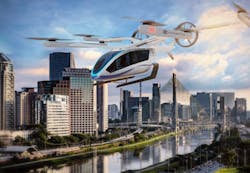These aircraft could change how we fly
CAMBRIDGE, Mass., - Some companies think it’s time the aviation industry got a makeover, and many are betting it’ll come in the form of eVTOLs: electric vertical take-off and landing vehicles. It’s a horrible acronym for small aircraft that take off and land like a helicopter and fly like a plane. (Typically, it’s pronounced ee-vee-toll, in case you were wondering.) Casey Crownhart writes for the MIT Technology Review. Continue reading original article.
The Military & Aerospace Electronics take:
17 March 2023 -The National Aeronautical and Space Administration (NASA) estimates that 130 million passenger trips may be taken by the year 2029. Some market prognosticators estimate the UAM market to grow from $2.2 billion in 2021 to $31 billion in 2031.
In the intervening years, the urban air mobility (UAM) sector of eVTOL flying taxis will need to see rapid adoption of regulations, best practices, and infrastructure investment to enable safe air travel in cities dominated by tall buildings, huge radio frequency (RF) transmission traffic, and soon, other aircraft
While many focus on passengers flying over traffic jams in city centers, the UAM sector is more broad than that. In addition to the promise of a flying taxi, autonomous eVTOL, hybrid, and traditionally fueled aircraft operators say they intend to find customers for air shuttles, personal air vehicles, air cargo, air ambulances/emergency vehicles, last-mile delivery, and similar military applications. These aircraft may be piloted remotely or with a pilot on-board or be fully autonomous in intracity and intercity routes.
Related: Urban air mobility gaining traction
Related: Honeywell has a new urban air mobility lab. Why does its avionics research matter for UAM?
Related: Hyundai's air taxi unit picks Honeywell as avionics supplier
Jamie Whitney, Associate Editor
Military + Aerospace Electronics
